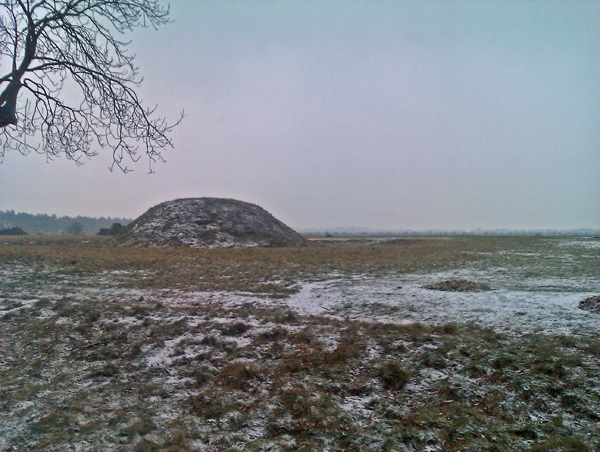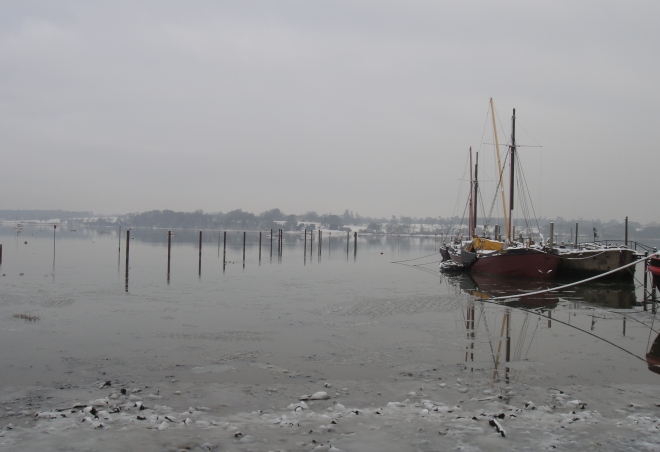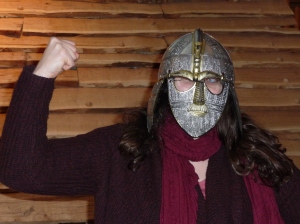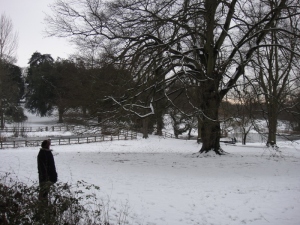Irresistibly, I am drawn back to our Wuffings and the beginnings of East Anglian Christianity. It may seem a dry subject to you, but for me it really helps to see how the region developed and took shape over those early years, and, like it or not, Christianity shapes the history of our region, our island, the whole of Europe. However, we know from many of the tales of mermaids and dragons, of witches and cunning men, of Syleham Lamps and fairy changelings, that the old ways – and human imagination – still kept their hold of the people of East Anglia, right up to today.
So, if you’ve read the previous blogs, A Puff on Wuffings and Woden or Christ? you’ll know that Rædwald made a hesitant half-start when it came to bringing of Christianity to East Anglian shores. He goes off into eternity honouring an entirely different set of gods, and Mound 1 – if it were to be his – is not the latest non-Christian burial there. Paganism held sway among some for a time, it seems. But the march of the White Christ pressed on in East Anglia, and circumstance would see it well entrenched by the time the dreadful Penda years came. Why such a quick turnaround? Bede once more has an answer, in the famous sparrow story told while Edwin’s court debates the issue of Christianity vs. their own existing religion up north in Northumbria.
Imagine the warriors of the court sitting on long benches around the central fire with the noble women passing amongst them pouring drinks while the debate rages on the long winter’s night. Outside, the wind howls, and sends the smoke from the fire buffeting through the room. An old warrior sits back and stares up into the dim, smoky recesses of the rafters. Can he make out a flitting shape there? Maybe a bird has strayed in out of the cold. Whatever he sees, it prompts him to make this famous speech:
Your majesty, when we compare the present life on man on earth with that time of which we have no knowledge, it seems to me like the swift flight of a single sparrow through the banqueting-hall … The sparrow flies swiftly in through one door of the hall, and out through another. While he is inside, he is safe from the winter storms; but after a few moments of comfort, he vanishes from sight into the wintry world from which he came. Even so, man appears on earth for a little while; but of what went before this life or of what follows, we know nothing. Therefore, if this new teaching has brought any more certain knowledge, it seems only right that we should follow it.[1]
The hope of a life after death for all, not only for those who were already rich and well-kept in this life was naturally desirable. With so much of the world in explicable except by supernatural means, religion and superstition had a power that many of us now cannot understand – at least while this little bubble of comfortable living we have constructed continues. Edwin’s chief priest, Coifi, sees the writing on the wall, and immediately declares that his religion is worthless, has got him no gains, when others, less devout than he, have gained more, then jumps on a stallion and rides off to destroy the idols in the grove nearby at modern day Goodmanham in the East Riding.
Bede makes it sound very easy – but he is a Christian monk, with a Christian axe to grind. Between the lines of this time you can see that it wasn’t, really. When Rædwald dies his remaining son, Eorpwald, becomes king. Edwin of Northumbria then becomes the Bretwalda, and power passes into the north – effectively, Eorpwald owes allegiance to Edwin, as Edwin had done to Eorpwald’s father. Edwin leans on Eorpwold, and the new king is christened. Events move fast. Eorpwald is killed by another member of the royal family, Ricberht, a pagan, and the kingdom reverts to paganism. Who knows what was happening to the populace, what faith they followed. In these times, it was all about kings.
For three years East Anglia stayed pagan, but then a new king arrived: Sigeberht. This young man had been in exile in France, which was already Christian, and Sigeberht had embraced the new faith wholeheartedly. There may have been a balance – at first Sigeberht ruled with another king, Ecgric, another Wuffing, who was probably a pagan – as, let’s face it, most people would have been in the Anglo Saxon areas of Britain before 650. But Sigeberht had a mission, and it didn’t take him long to put it into place.
First, he invited a French monk to join him to convert the masses. This was St Felix, for whom we get Felixstowe (probably). Felix was made a bishop and set up a cathedral in Suffolk , probably at Dunwich, possibly at Walton near Felixstowe. Unlike many of these early saints, he wasn’t a man for miracles. He seems to have got on with the job in hand with minimal fuss, only ensuring that the villages of the Saints (the Elmhams, Ilketshalls etc.) were difficult to access to keep them pure and holy, and then after death playing the usual game of dictating where his body was going to end up – he went to Soham, a church founded by the saint, and then to the inveterate relic-hunters at Ramsey, beating the monks at Ely by casting a convenient darkness that bamboozled the Ely monks and allowed the Ramsey ones to escape with their prize.
No, for miracles we need to look elsewhere – and the next blog will be about East Anglia’s first miracle worker – St Fursey.
Photograph © Kirsty Hartsiotis, 2013
[1] Bede, Ecclesiastical History of the English People, trans. Leo Shirley-Price (London: Penguin, 1990), pp. 129-30.













